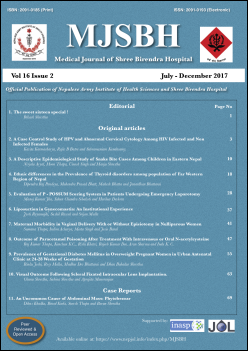Maternal Morbidity in Vaginal Delivery with or without Episiotomy in Nulliparous Women
Keywords:
Episiotomy, perineal tear, NepalAbstract
Introduction: Episiotomy incision is the most common surgical procedure around the globe and in many countries, it became a routine policy. Episiotomy in all women with vaginal delivery has no benefit. Rate of episiotomy varies widely around the globe, while in Nepal all nulliparous and primi-parous hospital deliveries are given routine episiotomy. So, this study aimed to compare the maternal morbidity during first vaginal birth in women with or without episiotomy.
Methods: This is a hospital based randomized prospective comparative study conducted in the Obstetrics and Gynaecology department of a teaching hospital. The subjects were divided into episiotomy group and no episiotomy group. Under local anaesthesia mediolateral episiotomy was given in the second stage with crowning of the head in episiotomy group. Nature of morbidity seen were recorded in both the groups immediately after delivery, after 6 hours and after 1 week and compared.
Results: In no episiotomy group intact perineum 26.3%, laceration 10.5%, spontaneous perineal tear (first and second degree) 63.1% was observed. Total perineal surgical repair was 81.55%. Intact perineum was high among no episiotomy group. Third degree tear, vulval haematoma, wound gaping, perineal oedema were seen in episiotomy group.
Conclusion: Anterior perineal laceration rate was high in no episiotomy group than episiotomy group but overall few morbidities were in no episiotomy group than in episiotomy group. So, episiotomy should not be considered to prevent insignificant anterior perineal lacerations.
Downloads
Downloads
Published
How to Cite
Issue
Section
License
This license enables reusers to distribute, remix, adapt, and build upon the material in any medium or format for noncommercial purposes only, and only so long as attribution is given to the creator.




